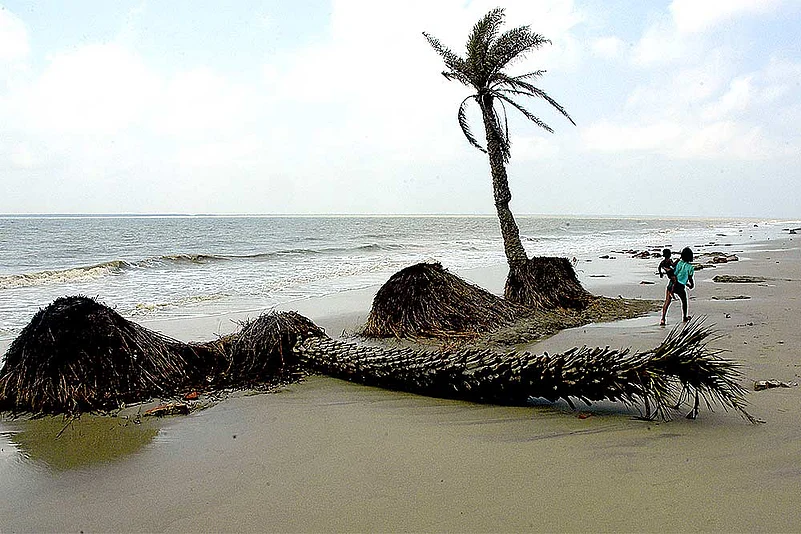Hamidul Rehman is angry. At 24, he has witnessed the sea swallow his home, situated on an island in the Sundarbans, the world’s largest delta, at least six times. Each time his family shifted further inward; each time the ocean pursued them relentlessly. “I can’t be mad at nature, can I?” he asks, his voice quivering with helpless rage. “But it makes my blood boil to see the administration’s attitude towards us. Neither state nor Centre has done anything to check the steady, alarming erosion of our land,” he adds.
While swathes of the Sundarbans—the western part of which falls in West Bengal—especially coastal islands on the Bay of Bengal like Ghoramara, Sagar Deep and Mousuni, are partially submerged, the plight of their inhabitants, out of sight from the mainland and thus at the bottom of priority lists of administrators, have largely gone unnoticed and unheeded.
They are not the only ones in grave danger. According to oceanographers, environmentalists and NGOs who have been tracking the Sundarbans’ gradual disappearance into the sea, the danger is no longer limited to the islands, but has reached the very doorstep of India’s mainland. Earlier this month, a group of experts convened a meeting to chalk out plans of bringing the issue to the urgent notice of governments—local, regional, national and international.
Environmental scientists say that the gradual depletion of the Sundarbans, which are covered in mangrove forests, will eventually have an adverse impact on the mainland, beginning with southern Bengal, including Calcutta, and gradually affect more parts of the country. According to a report of the Journal of Earth Science and Climatic Change, “Mangrove forests protect the coastal zone against the influences of ocean.... Relatively narrow strips of mangroves can substantially reduce the energy of wind-driven waves. Extensive tracts of mangroves can protect adjacent land and human populations from storm surges of water.... A healthy mangrove forest can prevent salt water intrusion, preventing damage of fresh water ecosystems and agricultural areas...and minimise the effect of rising sea levels due to global warming.”
Located at a distance of 175 kms from Calcutta, if the Sundarbans go down with all its mangrove forests, there is very little to protect the metropolis from the approaching, rapacious sea.
The question is why, in spite of the mangroves, are the islands eroding? “The chief cause of erosion in the Sundarbans is climate change and global warming,” explains Joydeep Gupta, South Asia director of the international environmental group The Third Pole. Because of CFC emission and greenhouse effect, temperatures across the world have marked a steady annual rise by one degree Celcius, leaving molten glaciers and rising sea levels in its wake. As seawater seeps inwards, salination causes permanent damage. Salinity has rendered the once fertile Sundarbans uncultivable, making traditional livelihoods like farming and sweet-water fishing impossible. Most alarmingly, it has caused the ground to become brittle which, when buffeted by dangerously high tides, crumbles and disintegrates.
“This has played havoc with the lives of the locals, who are poor farmers or fisherfolk and given rise to large-scale displacement, with islanders either trying to relocate to drier parts or fleeing altogether,” says environmental activist Jayanta Basu, who has been trying to bring the issue to the notice of authorities for the past 15 years. He points out that when Cyclone Aila ripped through the Sundarbans in 2004, killing hundreds and destroying thousands of homes, it demonstrated the magnitude of the problem—that manmade global warming had rendered the Sundarbans too vulnerable to withstand the effects of powerful natural calamities, unlike in the past. “The irony is that the people of the Sundarbans have contributed absolutely nothing to the carbon footprint responsible for global warming,” Gupta notes. In fact, other causes that have exacerbated erosion in the Sundarbans have also originated elsewhere. WWF scientist Anurag Danda explains that the landmass of the Sundarbans has traditionally depended on the silt that is carried to it by the Ganga, the main river feeding the delta. In recent decades, the thinning landmass is starved of this vital nutrient, for by the time the river arrives at the delta, its original course is subjected to so many upstream diversions that it just doesn’t carry enough silt.
The report cited above is also scathing about the effects of deforestation on the Sundarbans. “There has been an overall and continuous decline in mangrove forests caused by conversion to agriculture, aquaculture, tourism and urban development,” it says. Reduced mangrove will increase the threat to human safety and shoreline development from coast hazards such as erosion, flooding, storm waves, cyclones and tsunamis, it adds. This was proved glaringly during the 2004 tsunami, when villages which were protected by mangroves were virtually untouched; localities on either side of these, which lacked mangrove cover, were flattened as waves ripped through them.
So acute is the problem, so inexorable the damaging circumstances—rise in global temperatures, unabated diversion of the Ganga upstream etc—scientists have virtually lost hope of a fight to save the Sundarbans. The current focus has shifted from protecting and preserving the land/forest to managing the teeming thousands who face displacement. “The thrust of governments vis-a-vis the Sundarbans should be the absorption of the nearly 50 lakh inhabitants,” says Basu. Indeed, as the Sundarbans, slowly but steadily, looks set to go under, the impending socio-economic turbulence is much more exigent, feel environmentalists. Pointing out a possible administrative nightmare, they advocate prompt, crisis-evading decisions.
The hapless people of the Sundarbans are still not willing to accept the idea of mass displacement; they cling obstinately to the hope that the administration would miraculously save the land from disintegrating permanently. “All they have to do is put up the barriers and embankments which used be there before the Aila,” says Moirul Bibi, a resident of Mousuni island, whose mud hut is a mere two-minute walk from the last scene of devastation. “I was born and raised in this island. I got married here, had children and I’m a grandmother now. I don’t want to leave this place. But I will do everything to help the administration in recreating the buttress, even if it means digging up clay and buiding the mud mould with my bare hands and carrying heavy stone slabs to be pasted on top of the embankment to rebuff the sea.” Unwilling to accept the inevitable doom, she talks about having heard from a neighbour’s son about how the government spends crores on reclamation in Mumbai, where he lives now. “If they can create land on the sea where there is none, why can’t they protect land that is already there?” she asks. “Is it because we are poor and that is why our lives have no value?”
In the meantime, exasperated by the lack of response from not just governments but funding agencies, environmentalists have stepped up the demand for money. At the Sundarbans conference, Harjeet Singh of Action Aid International, who has been lobbying with governments of rich nations—chief contributors to the world’s carbon footprint—for funds to tackle the devastating impact of climate change, talks about their parsimony in this matter. “Funds have been abysmally inadequate,” he says. “Whatever little money that does come by is diverted through a complicated process via different governmental departments and banks and eventually gets lost in transition. So we have created the green climate fund as a one-stop solution. Our demand internationally is that beginning from 2020, each year $100 billion should be allocated for the purpose of work related to climate change.”
Meanwhile, the sorely disappointed Rehman is ready with an appeal, topped with a convincing argument, to environmentalists around the world for the protection of his home. “I am aware of the global fight to save the tiger from extinction,” he says. “Isn’t the Royal Bengal Tiger the world’s most famous tiger? Will they allow them to be engulfed by the sea?”
By Dola Mitra in Calcutta


























